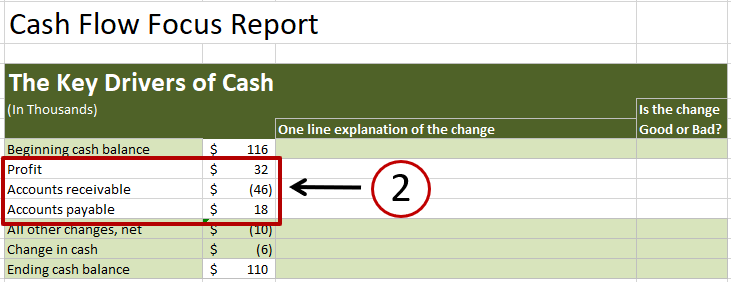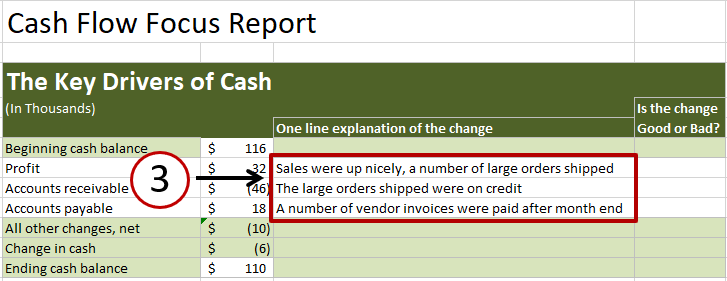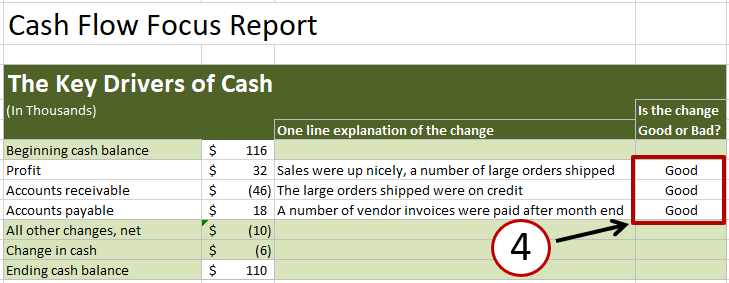In this post, I will show you the step-by-step process for completing the Cash Flow Focus Report. Before we look at each step, let’s recap the big picture monthly process for understanding your cash flow.
You have ONE goal at the end of each month:
Rate the quality of your cash flow on a scale of 1 to 10.
You do that by:
- Completing the Cash Flow Focus Report
- Writing the 2-minute conversation
The essence of the Cash Flow Focus Report is to:
- Focus on the three largest drivers (changes) in cash for the month
- Write a one-line explanation of each change
- Determine whether each change is good or bad
Your completed Cash Flow Focus Report provides the information you need to write your 2-minute conversation. The 2-minute conversation is where you understand your cash flow for the month so well that you can explain it to your business partner, banker (maybe even your spouse) in a simple, 2-minute conversation.
I like to write the 2-minute conversation down just below the focus report so I capture it and can look back on it later.
The order that we do this work each month is:
- Complete the Cash Flow Focus Report
- Write the 2-minute conversation
- Rate the quality of our cash flow on a scale of 1 to 10
And the goal is to do that work in 10 minutes or less.
The Step-By-Step Process for Completing the Cash Flow Focus Report
I’ll walk through each step in the process by using a real-life small business example. The business that we will complete the focus report for does about $1.5 million in annual sales each year. It’s a nice little company that was founded almost 20 years ago. It has grown nicely over the years and the owners love the business.
Last month, the business showed a profit of $32 thousand. But their cash balance went down during the month by $6 thousand (from $116 thousand down to $110 thousand).
Now let’s walk through each step in completing the Focus Report.
Run the Statement of Cash Flows report from your accounting system. Shortly after the end of the month, once you have reviewed your financial statements and closed the month, you are ready to print the Statement of Cash Flows report. In QuickBooks, the report is in the Company & Financial section under Reports.
Create a blank Cash Flow Focus Report. You can download the XLSX here.
Here are the four steps for completing the Focus Report together with the actual focus report for our example company.
Step 1: Drop in the beginning cash balance and the ending cash balance. Round the numbers from the cash flow statement in thousands. This is an important component of keeping things simple. So, a beginning cash balance of $116,235 would be $116.
As you can see, there is not much to step 1. Just enter the beginning cash balance for the month and the ending balance (from the statement of cash flows report).
Step 2: Identify the three largest drivers (changes) in cash. Find the three largest changes of cash for the month from the statement of cash flows you printed from your accounting system. Enter the category of change (like accounts receivable, profit or loss, inventory, accounts payable, debt service, etc.) and the amount of the change. Use the same sign (positive or negative) as is on the statement of cash flows.
While the statement of cash flow you print from your accounting system may have 30 or more lines of numbers, we only pull in the three largest drivers (changes) of cash on the focus report. By just pulling the three largest drivers of cash, we are focusing on the key drivers that impacted your cash for the month.
Step 3: Write a one-line explanation of the change. You will do this for each of the three largest changes. Keeping the explanation to one-line is important because it forces you to simplify your explanation.
If there is a stumbling block in your way to writing your explanation of each change, it’s the fact that there are lots of different drivers of cash flow. And understanding each change means you will be learning a little bit each month about how your financial statements work. The beauty of the Cash Flow Focus Report is that you get to learn about them in bite-sized pieces. Trying to learn about all of them at once is like trying to drink water from a firehouse. It doesn’t work (and it’s not real smart). We’ll do it in baby steps. A little bit at a time.
Step 4: Determine whether each change in cash is good or bad. You will do this for each of the three largest changes in cash. For example, if cash was down one month because you decided to pay down debt, that would be a good thing. If you increased your cash one month because you didn’t pay your vendors, that would be a bad thing.
The key point to keep in mind in evaluating each change in cash is that not all changes that reduce cash are bad… and not all changes that increase cash are good. Generally speaking, a change that catches you by surprise, or might spell trouble financially, would be labeled as bad. You’ll be surprised what you learn about your cash flow as you think about whether each of the three changes in cash is good or bad.
The 2-Minute Conversation
With the Cash Flow Focus Report completed, we have the information to write the 2-minute conversation. There are a couple different ways you can write this. The key is that you capture your understanding in a way that you find easy to understand. And that if you were to come back to it six months from now, it would instantly click for you what was going on with the cash for that month.
Here are two different ways to write this for our example company. The first one is the short and sweet version:
Cash was down $6k to $110k. Profit was healthy and on plan. Receivables were up because several large orders shipped and the invoices were outstanding at month end.”
Another way to write it is to provide a little more information to more fully document your understanding. Here is the slightly longer version:
We made good money this month on higher sales. We shipped a number of large orders to a great customer. But those orders were sold on credit (we invoiced the customer on 30-day terms) so we did not receive the cash this month. Accounts payable was up during the month because we had a number of vendor invoices that were entered as expenses, but they will not be paid until next month. As a result, the cash balance went down during the month from $116 thousand to $110 thousand. The good news is we expect to receive the cash from the large order next month so the “timing difference” in our cash flow should turn around nicely next month.”
Your Cash Flow Happiness Rating
Remember, we define cash flow as happiness. And we measure cash flow on a scale of 1 to 10. Ask yourself: “On a scale of 1 to 10, to what degree am I happy (satisfied) with my cash flow last month?” Where 1 is very unhappy (dissatisfied) and 10 is very happy (satisfied).
Here is what we put just below the 2-minute conversation:
Our Happiness Rating for the Month: 8
The owners were happy with their cash flow for the month… despite the fact that the cash balance was down a little. Profit was on plan and the fact that there were some large customer invoices still outstanding was not a problem. They were happy to have received the large orders, the orders were delivered on time to the customer, and the customer has a long history with them of paying their invoices on time.
The only reason their rating was not higher is they had set a goal at the beginning of the year that has not been achieved yet. The goal is to get their minimum cash balance more in the $200k range. It has been running in the $100k to $150k range and they want to beef that up as part of creating more financial cushion in the business.
The Drivers of Cash Flow
The next post in this series is titled Understanding the Drivers of Cash Flow. There are a dozen or so key drivers of cash flow in any month. Understanding each of those drivers means you will be learning a little bit each month about how your financial statements work.
The beauty of the focus report is that you get to learn about them in bite-sized chunks. Trying to learn all of them at once is like drinking water from a firehouse. It doesn’t work (and it’s not real smart).
We’ll do it in baby steps in my next post. 😊
Summary and Links to Other Posts in This Series
Here is a short recap and a link to previous blog posts in this series on making your cash flow simple and easy-to-understand.
Part 1 – The surprising results of my super-short survey that asked “How do YOU define cash flow in your business”?
Part 2 – “Cash flow” is not a single number on your financial statements. Now is the time to totally rethink (and greatly simplify) how you go about understanding and managing cash flow in your business.
Part 3 – I use a VERY different, simple approach to defining cash flow. It is an approach where I take my CPA and CFO hat off and speak in a common-sense language that you can relate to.
Part 4 – The Cash Flow Focus Report is a simple, common sense tool for understanding your cash flow that takes 10 minutes a month. It brings focus to your cash flow, simplifies your life, and leads to an understanding and sense of confidence that you will find freeing.
Part 5 – The four reasons cash flow has always been so confusing and complicated for business owners (and for bookkeepers and accountants too).
Philip Campbell is an experienced financial consultant and author of the book A Quick Start Guide to Financial Forecasting: Discover the Secret to Driving Growth, Profitability, and Cash Flow and the book Never Run Out of Cash: The 10 Cash Flow Rules You Can’t Afford to Ignore. He is also the author of a number of online courses including Understanding Your Cash Flow – In Less Than 10 Minutes. His books, articles, blog and online courses provide an easy-to-understand, step-by-step guide for entrepreneurs and business owners who want to create financial health, wealth, and freedom in business.
Philip’s 35 year career includes the acquisition or sale of 35 companies (and counting) and an IPO on the New York Stock Exchange.
Understanding Your Cash Flow – In Less Than 10 Minutes
This online course teaches you the step-by-step process for simplifying your cash flow. I walk you through each lesson while you watch, listen, read and try it yourself using your own cash flow numbers.
The course is very affordable. And there are also some coaching options available if you would like to get up and running fast.
It’s a fantastic way to learn the process.
I take all the risk out of your purchase because I include a 100%, no questions asked, money-back guarantee. You love it or you get your money back in full. Period.
There are two things that are very unique and exciting about this online course.
1. I’ll show you how to understand your cash flow in less than 10 minutes
2. I’ll show you how to explain what happened to your cash last month to your business partner or banker (or maybe even your spouse) in a 2-minute conversation.
I take off my CPA hat and I speak in the language every business owner can relate to. No jargon. No stuffy financial rambling. Just a simple, common sense approach that only takes 10 minutes a month.
Here is how one business owner describes the benefits of the course.
“I googled cash flow projections and found your website online and it appealed to me mainly due to the fact that you speak in laymen’s terms in a way that a non-financially trained person can understand.
The fact that you said you can understand your cash flow in less than 10 minutes a month was also a big reason I bought it. And the fact that you acknowledge that most accountants and CPA’s speak in terms that the normal owner cannot understand and that you would be able to put things in understandable terms really got me.
The monthly cash flow focus report was the best feature for me because learning to do it helped me understand my cash flow statements and the biggest drivers of cash flow.
Another significant benefit is the definitions of cash flow drivers and descriptions of how a negative or positive sway in cash within those drivers affects cash flow. Being able to see at a quick glance monthly what happened to your cash using the focus report is a huge benefit.”





Leave a Reply